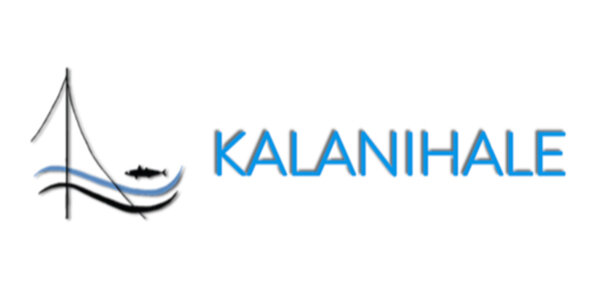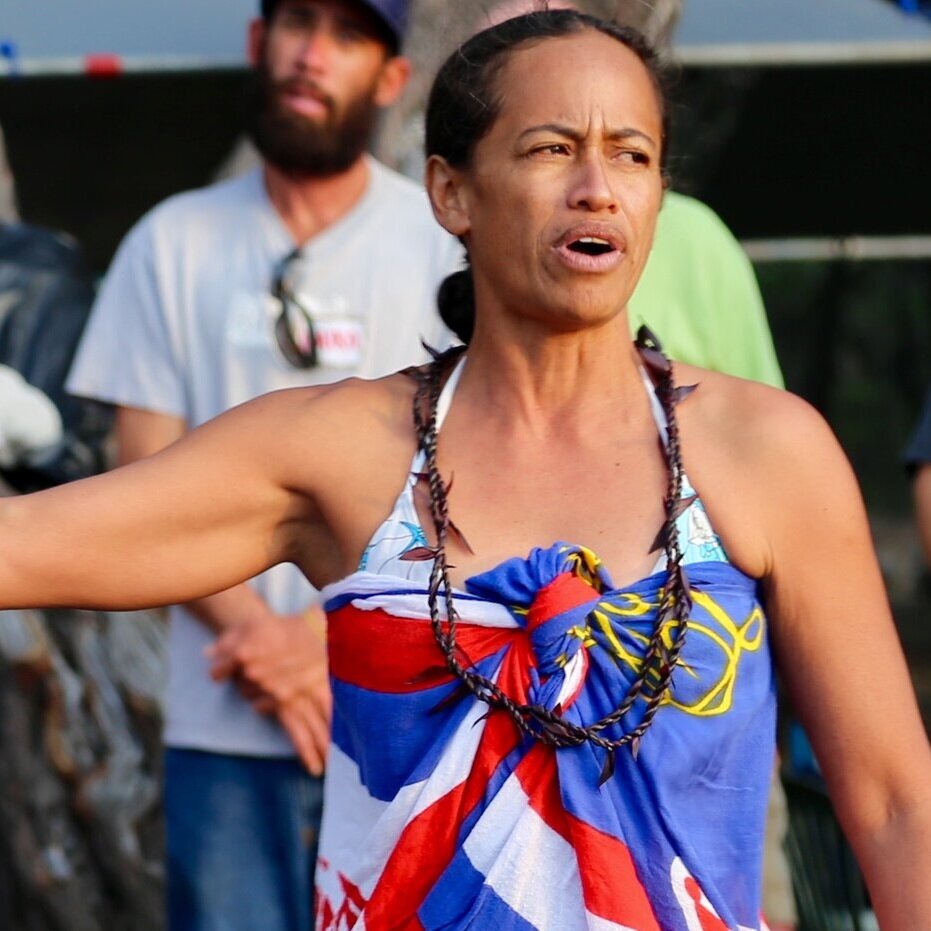On January 29, 2021, we got a chance to talk story with lineal descendants from three Kona communities that are participating in the process of planning and implementing community-based subsistence fisheries management areas. From Miloliʻi we were joined by Kaʻimi Kaupiko and Laila Kaupu. From Kaʻūpūlehu we were joined by Aunty Hannah Kihalani Springer. From Kīholo we were joined by Aunty Jenny Mitchell and Leighton Hind.
Kilo at Kīholo
Join our Hui Aloha Kīholo Hoa ʻĀina staff, Lehua Kamaka, in a time of kilo at Kīholo (jump to timestamp 9:49). Lehua describes the koholā jumping in the distance. In the ʻauwai we observe the freshwater from Ka Loko o Kīholo traveling out to the bay. The ʻauwai is described as the heartbeat of the fishpond, as it is the only surface pathway for water to travel into and out of the fishpond. This observation of water leaving the fishpond tells us that the tide is falling.
ʻAuwai of Ka Loko o Kīholo.
ʻIliʻili Beach at Kīholo.
Along the beach Lehua describes the seasonal changes of the ʻiliʻili beach that fronts Ka Loko o Kīholo. The large surf that accompanies the season of Hoʻoilo pushes the ʻiliʻili up the shoreline to create a steeper beach.
The waves that arrive on the shoreline also impact the rock walls of the ʻauwai. In August 2020 the ʻauwai was repaired after these waves had removed rocks from the wall.
ʻAuwai with damage from waves.
ʻAuwai after repairs.
ʻOhana of Kīholo and staff from Kaloko-Honokōhau National Park work to repair the ʻauwai.
What does abundance look like in your wahi?
Jump to timestamp 17:40 to join in on the discussion as Aunty Hannah, Aunty Jenny, Leighton and Laila describe what abundance looks like to them.
Aunty Hannah reflects on the time when her grandfather and the residents of the kaha lands gathered for the dedication of Kaikalaʻia Church at Makalawena, a time when the people who lived here utilized the coastal resources frequently. This is in contrast to today when we see many more people utilizing the coastal resources less frequently, but the cumulative impact of so many people is greater than it was in the past. Abundance to Aunty Hannah would be the return of balance between kānaka and our natural resources in the ocean.
Kīholo, Kona ʻĀkau.
Aunty Jenny tells of her experiences as a child and the stories that were told to her of the abundant fish resources at Kīholo. She shares stories of being able to travel to Kīholo without having to bring too much food because the ʻāina could feed you. Leighton reinforces these ideas of abundance at Kīholo to say that the return of large schools of fish, and the ability to experience them with ʻohana is his view of abundance.
Miloliʻi, Kona Hema. Photo provided by Laila Kaupu.
Laila speaks of the importance of feeding keiki and ʻohana physically and spiritually, being guided by Native Hawaiian traditional cultural practices. Abundance to Laila is mālama ʻāina, the ability of a community to develop a relationship with ʻāina. Her image of abundance is the image of a thriving community, as it is a reflection of thriving natural resources in the kai.
When did you or your ʻohana or your community recognize the need for adaptive place-based fisheries management?
Jump to timestamp 28:42 to listen to Aunty Hannah, Kaʻimi and Aunty Jenny talk about the changes they have seen in their communities.
Kaʻūpūlehu, Kona ʻĀkau. Photo provided by Hannah Kihalani Springer.
Aunty Hannah describes historical changes that have impacted abundance in Kona such as the fishpond of Paaiea at Keahole that was filled with lava in 1801, and the establishment of the 600 acre fishpond Wainanaliʻi at Kīholo. Contemporary changes in these areas were catalyzed by the creation of the Queen Kaʻahumanu Highway in 1975, which allowed for the establishment of resorts and irrigated golf courses, and increased public access to the shoreline, resulting in a decline in coastal resources.
Teaching ʻōpelu fishing practices to youth in Miloliʻi, Kona Hema.
Kaʻimi describes Miloliʻi’s connection to ʻōpelu fishing, and how their community saw the need to create opportunities for the youth to learn the traditional practices of ʻōpelu fishing and caring for their local resources.
Kīholo, Puʻuwaʻawaʻa, Kona ʻĀkau. Photo credit: Chad Wiggins
Aunty Jenny explains that for Kīholo, the establishment of the Queen Kaʻahumanu Highway increased access to the area, but the road down to Kīholo was still gated. In the early 2000’s the gate was opened to the public and there was a period of overuse when hundreds of people were living in the lava fields at Kīholo. It was apparent to the families of the area that a change needed to happen, and they began to organize and advocate to mālama Kīholo.
What successes and challenges have you experienced in your journey to mālama ʻāina?
Jump to timestamp 44:22 to hear Aunty Hannah, Laila and Leighton as they reflect on the successes and challenges of mālama ʻāina.
Aunty Hannah reflects on how the community has contributed to success in the form of learning from the kupaʻāina who came before us, and working together with those who are on the ʻāina today. She describes that people in opposition of closure, as well as a lack of protection of the traditional Hawaiian practice of mālama ʻāina in the current legal system, are among the challenges experienced in the process of establishing a 10 year all-species fishery closure at Kaʻūpūlehu. Aunty Hannah also describes the process that their community went through to establish the Try Wait 10-year rest period at Kaʻūpūlehu including a Conservation Plan, meetings, monitoring of intertidal, fish and benthic populations, and participating in the FishPath Fisheries Management Planning process.
Miloliʻi, Kona Hema. Photo provided by Laila Kaupu.
Laila talks about her experience of documenting the Miloliʻi community’s traditional knowledge of place and resources that has been passed down for generations.
ʻOhana and community members working together to repair the ʻauwai of Ka Loko o Kīholo.
Leighton speaks to the importance of having a presence on the land every day to develop an intimate relationship with the ʻāina to understand the health of resources and the changes that occur through different seasons. He describes the biggest challenge as getting everyone on board, being open to change, and listening to different perspectives.
What is your message to the world?
Jump to timestamp 1:07:02 to listen as each of our guests shares their inspirational messages to the world.
“Be outside. Be in place. Pay attention.”
- Aunty Hannah Kihalani Springer
“Mālama ʻāina like it’s your kūpuna.”
- Laila Kaupu
“Our resources are our lives.”
- Kaʻimi Kaupiko
“Community management is the future.”
- Leighton Hind
“When we are there to aloha our ‘āina, and aloha each other,
then we are in the right waʻa.”
- Aunty Jenny Mitchell
Learn More & Get Involved!
Our Aloha Friday LIVE Guest Speakers
Hannah Kihalani Springer,
along with three generations of her family live at their ancestral home, Kukuiʻohiwai, on the cool upper slopes of Kaʻūpūlehu. Since 1996, she has been a participant in the Kaʻūpūlehu Marine Life Advisory Committee (KMLAC). In 2016, the KMLAC successfully petitioned the State of Hawaiʻi for a ten-year, all-species rest period, from the shoreline out to a depth of 120 feet. The KMLAC is preparing a Fisheries Management Plan for review and comment in anticipation of the rest period ending in 2026.
Kaʻimi Namaielua Kaupiko
is a keiki o ka ‘āina of Miloliʻi. He grew up learning the traditional fish practices of Miloliʻi, which remains one of Hawaiʻi’s last fishing villages, an isolated community that survives through subsistence fishing. For Kaʻimi his foundation has always been built on education and culture. He grew up learning from his kūpuna about the value of hard work and about the need to take care of this place. He has served his community by establishing a non-profit, teaching through the Kua o ka Lā Hipuʻu program, and his true passion is to help provide a space for the future generations of his community, and to the rural areas of South Kona and Kaʻū, to have access to educational models that fit their learning capabilities.
Laila Kaupu
was born and raised off the Kona Hema slopes of Mauna Loa, not just from the little fishing village of Miloliʻi but also had the privilege of being raised on a neighboring ahupuaʻa that is ʻohana ʻāina called Omokaʻa. She is privileged to have been raised with the traditional practices of fishing and gathering from the ocean taught to her by her grandparents, and the kūpuna of the village. She continues to pass on these traditions to her son Pohaku and through community outreach opportunities including Miloliʻi Lawaiʻa Camps, Konohiki, Marine Management, and Makai Watch.
Aunty Jenny Mitchell
is a co-founder and the Board President of Hui Aloha Kīholo in addition to being a lineal descendant of Kīholo. As a niho stone in the foundation of our organization her love for place and people elevate our staff and the work we do to care for Kīholo.
Leighton Hind
grew up with his cousins at Kīholo where they played in the water all day and learned how to fish, dive, catch waves and make imu. He is a descendant of the ahupuaʻa of Puʻuwaʻawaʻa, and of Kīholo. Kīholo is where he was told the stories of his kūpuna and learned family values and traditions. This created a deep knowledge and love for his ancestral lands which he still helps to steward today as a Hoa ʻĀina with Hui Aloha Kīholo.
Lehua Sandy Kamaka
is one of our Hui Aloha Kīholo Hoa ʻĀina. In collaboration with our partners, Hoa ʻĀina, or “friends of the land” monitor and protect natural and cultural resources, engage with and educate visitors, and manage camping. By creating a community of stewards, with visitors, kamaʻāina (locals), partners, and advocates, Kīholo can continue to thrive culturally and environmentally.
Glossary
ʻāina - land, earth
aloha - love, affection, compassion; to love; to show kindness, mercy, charity, affection
ʻauwai - ditch, canal
hoa ʻĀina - tenant, caretaker; literally “friend of the land”
hoʻoilo - winter, rainy season
hui - club, association, society, organization; to join, unite
ʻiliʻili - pebble, small stone; to pile, overlap
kai - sea, seawater; area near the sea, seaside, lowlands; tide, current in the sea
Ka Loko o Kīholo - the fishpond of Kīholo
kānaka - plural of kanaka; human being, person, individual
Kanaloa - A major god
Kāne - The leading of the four great Hawaiian gods
Kaʻūpūlehu - ahupuaʻa in North Kona; literally “the roasted breadfruit”
Keahole - ahupuaʻa in North Kona; literally “the āhole fish”
keiki - child, offspring, descendant
Kīholo - coastal embayment in the ahupuaʻa of Puʻuwaʻawaʻa; large wood fishhook, as used for sharks and large fish; large fish net about 20 fathoms long, held by a canoe at each end; long ti-leaf food package, more commonly called holo ʻai
kilo - to watch closely, spy, examine, look around, observe, forecast
koholā - Humpbacked whale
Kona - the name of two districts on Hawaiʻi Island (North and South Kona)
kupa ʻāina - aboriginal inhabitants
kūpuna - plural of kupuna; grandparent, ancestor
Makalawena - ahupuaʻa in North Kona; literally “attractive eye”
mālama - to take care of, tend, attend, care for, preserve, protect, beware, save, maintain
Miloliʻi - traditional Hawaiian fishing village in South Kona; fine cord twisted from fiber
ʻohana - family, relative
ʻōpelu - mackerel scad
waʻa - canoe, rough-hewn canoe, canoemen, paddlers
Are there more Hawaiian words that you want to know the meaning of? Go to www.wehewehe.org to search the online Hawaiian-English dictionary.
Pukui, Mary Kawena, Samuel H. Elbert. Hawaiian Dictionary. University of Hawaiʻi Press. 1986. Honolulu. <www.wehewehe.org> Accessed February 19, 2020.
























